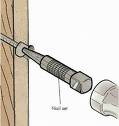
REPAIRING SURFACE DAMAGE
ON STRIPPED OR UNFINISHED FURNITURE
Unfinished and furniture is likely to have a few problems. The joints may be loose; moving parts may stick. There are usually a few knots in the wood, and in the case of fairly recently constructed unfinished furniture, these will bleed through the finish if they aren't sealed. There are almost always rough edges or saw marks in unfinished furniture, filled and disguised areas in previously finished items. Before preparing the wood for finishing, or refinishing if previously stripped, we take the time to deal with these problems.
Loose Joinery and Poor Assembly
The first step in working with unfinished or stripped furniture before applying the final finish is making sure it's solid. We check the joints to locate any weak points; drawers are especially likely to need refastening. If the staples or other fasteners are solid, renailing may not be needed, but if they're off-center or don't look very secure, we reinforce them by driving finishing nails next to them. We drill pilot holes for the nails to keep the wood from splintering. If the staples are loose, we pull them out with pliers, and renail the joint. Staple holes are filled with wood filler.
Loose legs, rungs, arms, or spindles will be reglued. We test all parts of the piece to make sure they're secure, and reglue or refasten any loose part.
If the piece has drawers, they should work smoothly. Drawer guides are checked, inside the frame, and the runners on the bottom edges of the drawer. They should be square and securely fastened, with no protruding nail heads. Guides or runners are refastened, if necessary, and countersink protruding nail heads with a nail set.

The wood is examined carefully for spots where sap has flowed or resin beaded on the surface. Hardened resin is scraped off , and clean knots and sap pockets are cleaned with turpentine on a soft cloth. If large knots are loose, they are removed entirely; then carpenters' glue is applied around the edges and the knots replaced, flush with the surface.

knot
Rough Edges
To correct surface roughness, edges are sanded smooth. If there are low spots or gaps in an edge, we fill them with wood filler or water putty and then sand the filler smooth. Square edges will be very slightly rounded before finishing; we smooth and round them with fine-grit sandpaper on a sanding block. We do not plane edges; planing can splinter the wood.
Saw Notches and Splinters
Dull saw blades leave notches and splinters, and you're likely to find these problems anywhere the wood has been cut or joined. If the notches are very shallow, we may be able to sand them out. In most cases, they have to be filled with wood plastic, and then the filler sanded smooth.
Special Finishing Steps
Unfinished furniture requires the same preparation and finishing as stripped furniture, but it also requires a few preliminary steps.
First, the wood must be sanded very thoroughly. Unfinished pieces are usually rougher than stripped pieces; sanding starts with medium-grit sandpaper and then worked up to fine-grit, ensuring all edges, knot faces, joints, and door and drawer interiors are completely smooth.
Raw wood will be carefully sealed. Unsealed wood absorbs moisture, and this can cause serious problems. If the piece of furniture has drawers, they are sealed inside and out with a coat of thinned white shellac or sanding sealer, to prevent warping and splitting. All hidden parts are sealed -- drawer guides, side and bottom panels, and any other exposed wood. Then the entire piece of furniture is sealed, and lightly sanded to remove any rough areas from the surface. Any further finishing you would like can now be done.



 LOCATION
LOCATION
